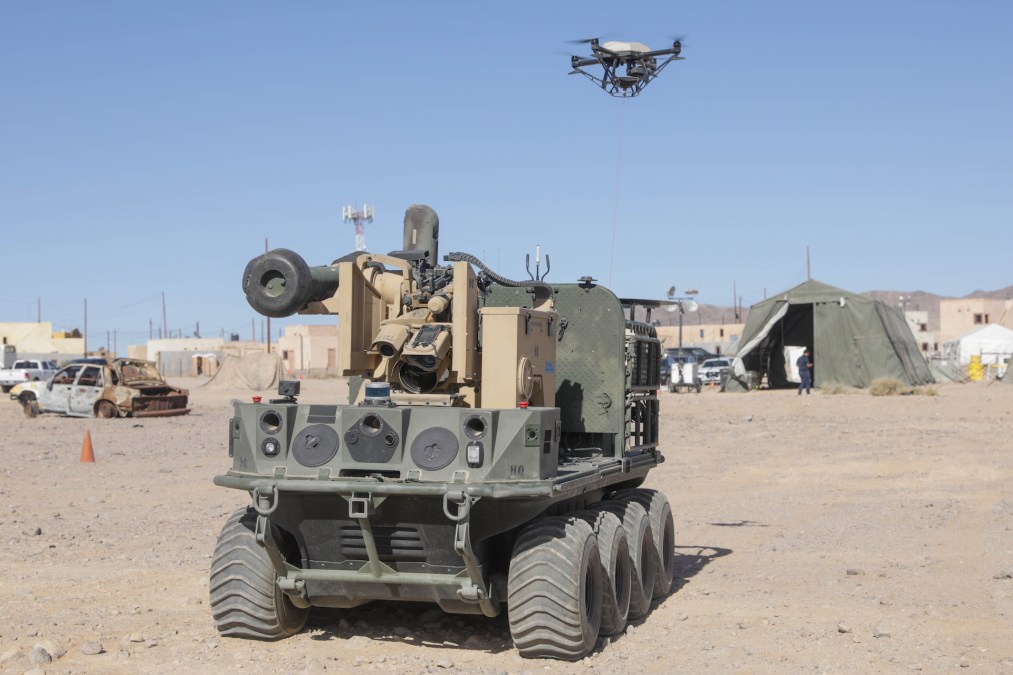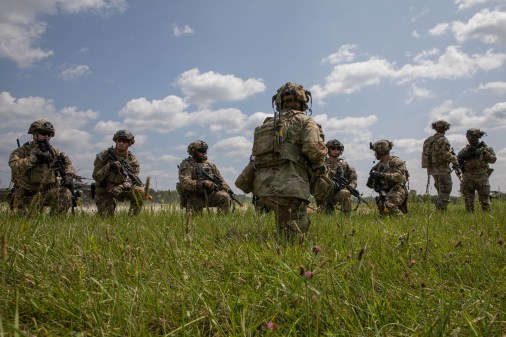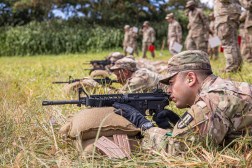‘The simpler, the better’: Army learning lessons from soldier experimentation with robotic vehicle controllers

The Army is gaining important insights from troops as it looks for the most effective ways to control robotic combat vehicles and other unmanned platforms, according to officials.
These technologies and concepts will be critical as the service fleshes out its plans for what it calls “human-machine integrated formations.” The Army wants to have robots, not soldiers, “make first contact with the enemy,” Army Secretary Christine Wormuth said Monday at the annual AUSA conference.
Officials expect uncrewed systems to increase situational awareness, lethality and tactical options for Army formations in support of multi-domain operations. For example, robotic combat vehicles (RCVs) could serve as scouts or escorts for manned fighting vehicles. The plan for the first generation of RCVs is for operators to remotely control them or task them to operate semi-autonomously.
Commonality is a key theme of Army’s vision for unmanned systems, according to officials.
“That’s in the sense of ideally common platforms but different payloads to make it easier to employ — and a common network so we’re able to operate this seamlessly across the network — as well as common controllers. [That’s] something we’re working hard down in our maneuver capability development integration directorate. You don’t need soldiers walking around with nine different controllers to control robotic capability out there,” Maj. Gen. Curtis Buzzard, commanding general of the Army Maneuver Center of Excellence and Fort Moore, said during a panel Monday at the AUSA conference.
The service aims to field light variants of robotic combat vehicles by fiscal 2028, and it’s been experimenting with related technologies and surrogate systems for several years.
“With the robotic combat vehicle experiments, we’ve tried a number of different controllers and got really great feedback,” Brig. Gen. Geoffrey Norman, director of the next-generation combat vehicles cross-functional team at Army Futures Command, told DefenseScoop at the conference.
“Some of the feedback that was a little surprising as it related to having really elegant Formula One style controllers that were actually less popular than just a simple laptop-keyboard-mouse setup that the gamers might be more familiar with. So we’re gaining insights on those controller demands. But the key thing is that regardless of what the physical construct is, that the software that’s running behind them is common and that the interface allows the soldier to go from one platform to the other to another without having to learn a new software system. There’s an interface that’s common across them,” he added.
Some of the feedback from troops is they want “simple things,” noted Michael Cadieux, director of the Ground Vehicle Systems Center at Army Combat Capabilities Development Command.
A key consideration as the Army looks for the right controller technology is the ratio of humans to machines on the battlefield.
“Right now, it’s can you get to one operator to control two robots? But we’re thinking in the future, how do I control swarms? The operator at [the National Training Center] said, ‘You know what I don’t need [is] this kind of steering wheel that looks like an F1 steering wheel. Give me a mouse and a keyboard because I am … [playing the video game] War Thunder every day. And I can absolutely control multiple robots and their payloads from a mouse and a keyboard. And so that’s some of the feedback that I think is interesting,” Cadieux said.
The service has also been working with dozens of industry partners as it experiments with unmanned systems and supporting technologies, he noted.
Major lines of effort from a tech perspective include maturing components on the base platform itself as well as the underlying architecture.
Stakeholders need to know how to rapidly integrate “mission modular” payloads, he noted.
“From a software perspective, how do we do it where it’s cyber secure, where it doesn’t require reprogramming of a unique controller and 12 months of interfacing design, but something we can do it very quickly, we understand how the data can be consumed within that common controller?” Cadieux said.
Soldiers need to be able to transfer control of systems easily, Buzzard told DefenseScoop.
“One may be a sensor capability; one may be a loitering munition. [But] you want to be able to seamlessly control and hand-off targets and capabilities across a formation,” he said.
Buzzard said he doesn’t necessarily favor a particular design for robotic vehicle controllers at this point. But whatever devices are ultimately fielded, the Army needs to make sure they don’t burden end users.
“We want something that soldiers naturally are able to use easily and can migrate to,” he said. “What we don’t want to do is … we’ve got five different things we need to employ and we’ve got to carry five different controllers with five different batteries that require five different types of training. And so the simpler, the better, just from the perspective of the Maneuver Center … It’s just a simple, you know, rugged capability.”
The Army plans to experiment with different controllers in the next couple weeks at Fort Moore, Georgia, and again early next year during advanced expeditionary warfighting experiments.
Last month, the service announced that McQ, Textron Systems, General Dynamics Land Systems and Oshkosh Defense have been tapped for phase one of a prototyping effort for the RCV-Light program.
The program of record is essentially two programs, according to Norman: the vehicle itself and the software that will support the hardware.
“There is an accompanying software acquisition pathway that underpins the Robotic Combat Vehicle-Light effort that is going to be based fundamentally on a modular open system architecture. And it will allow for the government to rapidly iterate and bring in best-of-breed capabilities into this open architecture so we can have the best software solvers developing solutions to our problems,” he said.






